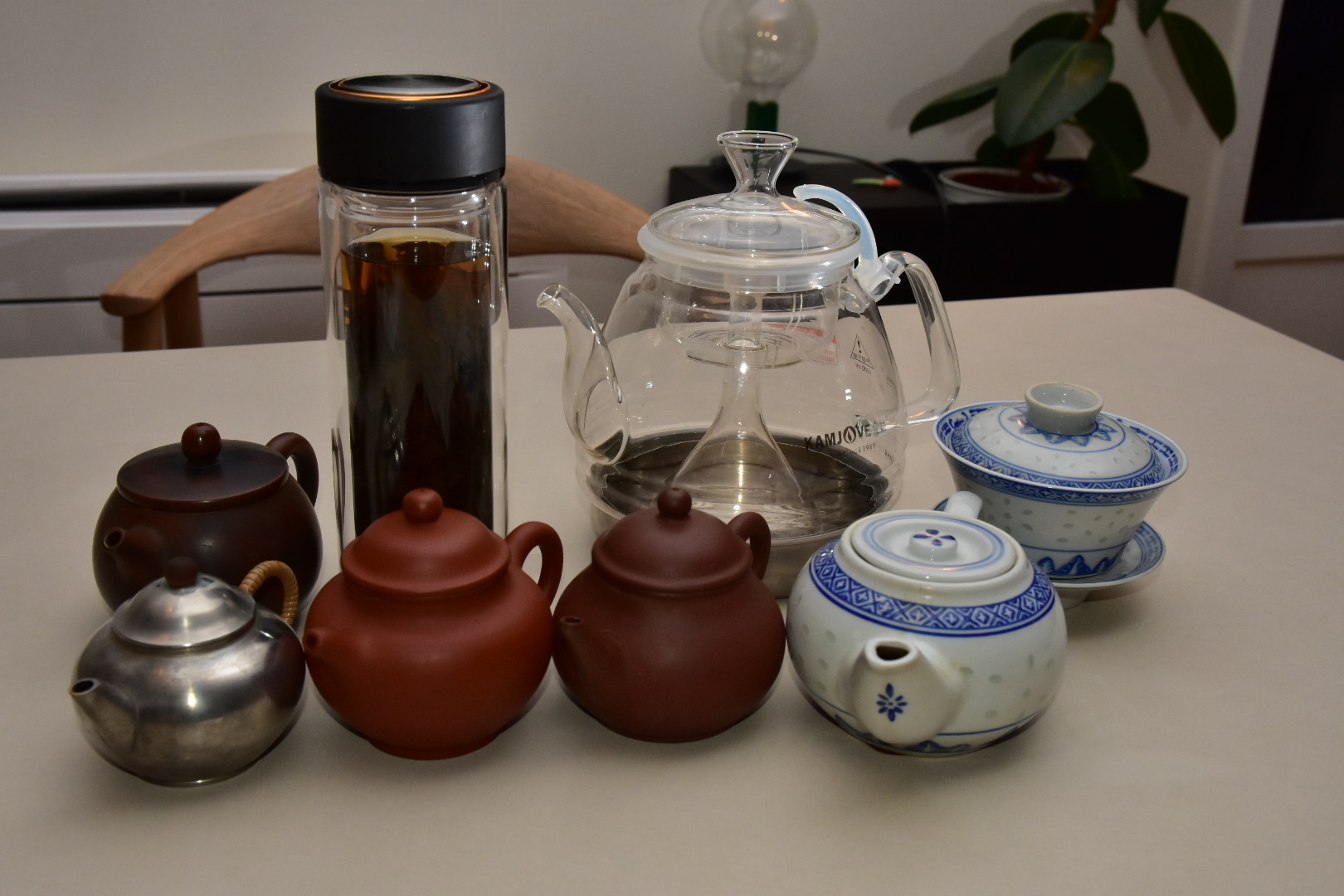Some questions come up a lot. I’ll try to answer them here. This page is very much a work in progress.
What kind of brewing vessel should I use?
There are only two true answers to this, and they’re equally boring:
1) It depends
2) A porcelain gaiwan
Really, most brewing vessels will be fine. For most of the teas I offer there are important points to consider: you don’t want too much muting and you want proper heat retention.
The poorly lit and composed image below shows my go-to vessels for Anhua heicha. From left to right, back to front, they’re a (modern) nixing pot (~260 ml), an insulated glass bottle (~420 ml), a glass stovetop kettle (>1l), a porcelain gaiwan (~200 ml), a tin pot (~160 ml), a hongni pot (~230 ml), a zini pot (~230 ml) and a porcelain pot (~300 ml)

The odd ones out are the glass flask and stovetop kettle. The former I use whenever I’m out of the house (= everyday), it’s fantastically versatile and I’ll either do a kind of bastardized gongfu where I pour into another cup and use a fork to avoid leaves escaping, or just grandpa brewing. Anhua heicha - particularly productions with coarser material - are very well suited for granda brewing. The stovetop kettle I only use occasionally, for boiling (excellent way to brew dust and sediment left behind from breaking up slices and cakes, more so for stuff with some age).
For teapots/gaiwans I rarely go below 180 ml, except for the tin pot which has excellent heat retention. (And no, you really don’t need a tin pot. If you do get one, be careful with antiques; I wouldn’t dare using an untested one because… lead)
If in doubt, go for porcelain in the 180-250 ml range. Underfilling a larger vessel is fine.
(For tianjian material productions, especially loose leaf ones, using smaller vessels is fine too.)
What about brewing parameters?
Counterintuitive as it may sound, I recommend starting with more leaf than you think you need, and then gradually move your way down from session to session (good thing about these QLC slices - you’ll have enough for plenty of sessions!) until you hit the right spot for you.
Assuming a 150 ml porcelain vessel and a QLC with a mix of grade 2/3/4 material, I’d start with something like 12-15 grams. Quick rinse, which is discarded. Longish first brew (1-1,5 minutes - though for tightly compressed stuff you might need to go up to twice as long), slightly shorter second and third brew. And then go by feeling from there.
(For tianjian material productions, especially loose leaf ones, usually demand less leaf. I brew this like I would brew most liubao.)
Does the teas need to rest after shipping?
It is not strictly necessary, but my experience is that Anhua heicha greatly benefit from rest after shipping. I usually go with 2-4 weeks (rule of thumb: Never shorter than 2 weeks, and at a minimum the same time it took for the package to arrive) of resting time. I prefer to let them rest with humidity. (I use mylar bags for storage)
Though with the unit sizes of most of these teas, there’s no harm in trying them earlier.
Should Anhua heicha be stored with or without added humidity?
For the majority of Western storages: With humidity. In terms of temperature and humidity I treat Anhua Heichas like I treat sheng puer. 69% or 72% bovedas, depending on what I happen to have at hand. If I were to pick one of those numbers, I’d go with 69%.